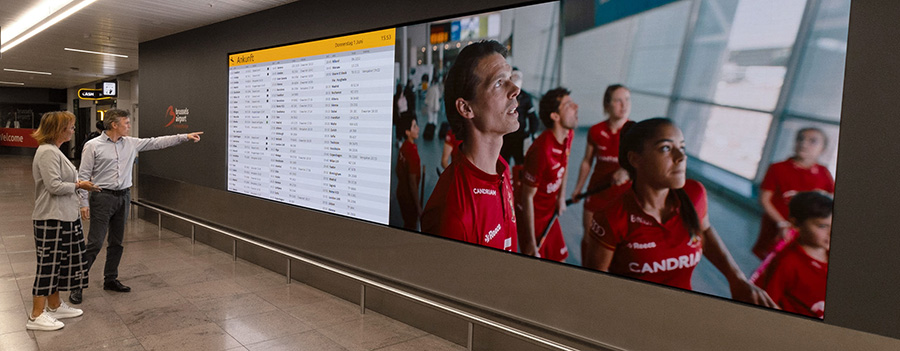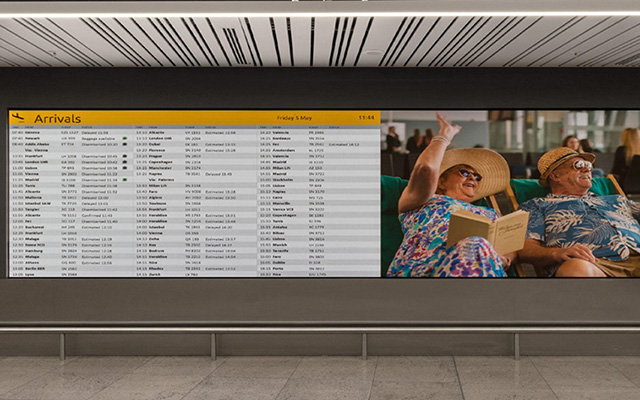
Brussels Airport Transitions FIDS Video Walls From LCD To Fine Pitch LED
July 14, 2023 by Dave Haynes
It was always just going to be a matter of time when fine pitch LED costs would reduce to a point that they would fully supplant LCD-based video walls, and we appear to be there even with pedestrian use-cases like FIDS displays at airports.
The airport in Brussels, Belgium has flight information (FIDS) videowalls that used 46-inch NEC narrow bezel displays for the last seven years. They were NEC, so they probably still looked good and worked well even at seven years, but they would be starting to age out.
The walls now use 1.2mm LED from the Sharp-NEC display line-up.
This quick case study goes into the who, what, when, where and why stuff:
As a long-time trusted supplier to Brussels Airport (since 2014), Sharp/NEC won the tender for the frame contract for the second time, maintaining its preferred supplier status for all FIDS displays and LED walls. Fire safety is a critical requirement in the airport environment and NEC display products are proven to be compliant to standards set by the airport’s Fire Safety Office. Sharp/NEC products come with a temperature monitoring and control system to trigger power shut down should it become necessary to prevent overheating and fire.
In comparing a 1.2mm and 1.5mm pixel pitch side by side, after a period of evaluation the team at Brussels Airport selected the LED-FE012i2 product with a finer pixel pitch ensuring the clarity and readability of flight information from close distance.
“We were able to rent demo devices with alternative dot pitch specs which made it possible for us to experiment, test and compare different content on each LED wall. In this way we were able to define the ideal font size for the flight information,” explains Bert Devue. “The FE-series was selected not only because of budgetary reasons, but also because the full redundancy offered by the FA Series was not required in this area of the terminal.”
Reducing the Total Cost of Ownership (TCO) was one of the main reasons for choosing dvLED over LCD technology: “In our experience with NEC LCD video wall technology, operating 24/7, the lifecycle is typically 5 to 6 years. However, with LED technology, we are looking to achieve a lifecycle of at least 10 years. With a longer lifecycle, we are reducing waste making it a sustainable choice too. LED has a much lower power consumption, reducing operating costs and minimizing the cost of ownership over the longer period.”

The two new LED screens display a mix of flight information and airport branding content. As visitors wait for passengers to pass through the arrival’s hall, they are kept up to date with flight information and entertained by inspirational content about various travel destinations alongside success stories about sustainability and supporting good causes.
“The LED walls combined with creative content will contribute to a nice experience for our visitors, reducing perceived wait times while they anticipate the arrival of their friends and relatives,” confirms Bert Devue.
“Currently, each LED wall is split into two sections each driven by a CMS media player from Centomedia. Soon we will connect a single CMS player to manage the entire wall enabling more flexible use of the bezel-less surface and maximizing its full potential.”
I like, but do wonder a little about the durability, as the LED series used is conventional SMD LED – meaning the light emitter packages are micro-soldered on and pretty easily damaged. Newer but likely more expensive manufacturing methods like COB offer more durability against accidental or purposeful bumps and other mishaps.
The image does, however, show a kick rail that keeps travellers back a d little, and the display is above the height of passing luggage and other things being hailed or pushed.
LED displays for FIDS are not a new thing, but they have tended to be the BIG overhead displays at the head of concourses or pre-security grand halls – where viewing angles are fairly long and lower-rez pitches work. This is up close, and 1.2mm does the job of showing destinations, times and gates clearly even at close quarters.



Leave a comment